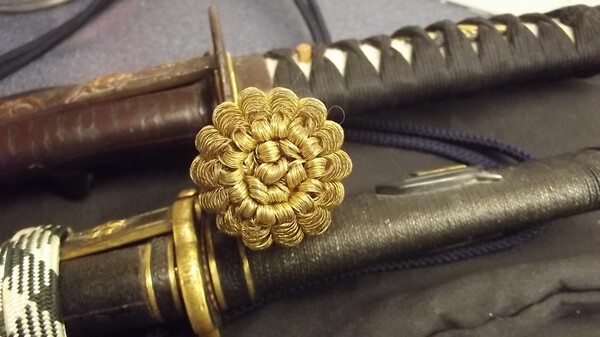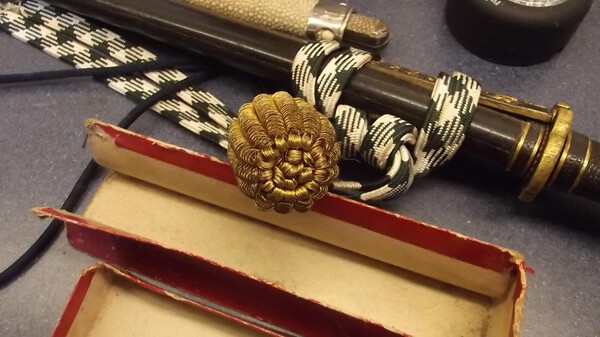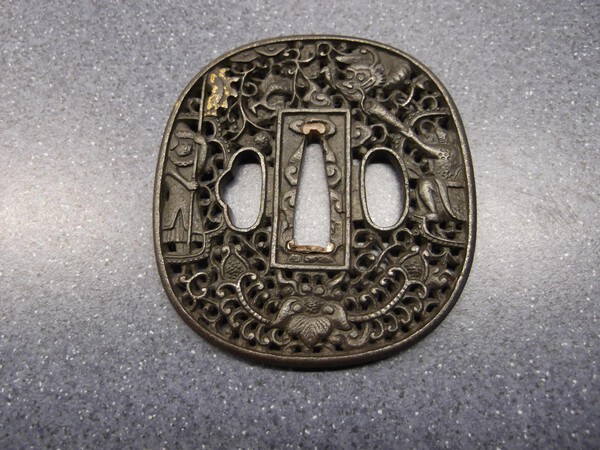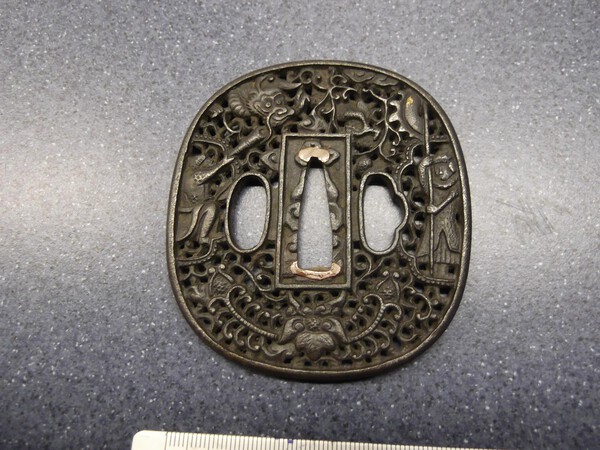
DAHM
Members-
Posts
16 -
Joined
-
Last visited
Content Type
Profiles
Forums
Events
Store
Downloads
Gallery
Everything posted by DAHM
-
Unidentified Possible Kyugunto Sword Knot
DAHM replied to DAHM's topic in General Nihonto Related Discussion
Hi, all. I'm not 100% certain, but I think this knot may turn out to be a French, Inter-War period officer's knot! The knot's cord was produced in a variety of colours, including blue, black, brown and khaki. Never trust a dealer! Best wishes, David -
Unidentified Possible Kyugunto Sword Knot
DAHM replied to DAHM's topic in General Nihonto Related Discussion
The bottom line is that I don't know that this is a kyu gunto knot. It was sold to me years ago by a dealer who said it was. I have posted it on this forum for comment and assistance. If it is not a kyu gunto knot then it is a knot for something else. The quality of the artefact speaks for itself - perhaps this particular forum is the wrong one for it. Best wishes, David. -
Unidentified Possible Kyugunto Sword Knot
DAHM replied to DAHM's topic in General Nihonto Related Discussion
I'm grateful to those members who have had a look and made comment. Obscure and/or as yet unidentified items intrigue most collectors - I am still, after many years, surprised at how little authoritative material has been published on items such as sword fittings. I did send the images (a few more are attached here) to Richard Fuller, who has written extensively on, among other things, Japanese sword accoutrements. He hasn't seen one with a blue cord before. ChrisW has pointed out that material colours sometimes fade over the years, and I can confirm that direct sunlight has done this to at least one artefact of mine. In this particular case, I did move the slider on the cord to see if there was any change in colour where the cord meets the main body. There was not - it has always been blue. The length of the doubled-up cord to the main body is 43.6cm, or approximately seventeen and a quarter inches in old money The full length of the knot to the point where it meets the cord is 9.7cm (approx. 4 inches). -
Hi, all. I'm posting images of an as yet unidentified sword knot which was originally sold to me many years ago as a kyugunto model. As you will see from the images the cord is actually a shade of blue - somewhere between Royal and Navy. I think the generals' version is supposed to have a black cord. Can anyone help to ascertain its identity? David.
-
Hi, Mauro. Many thanks for taking the time to give your opinion. Another, much more knowledgeable acquaintance agrees with your thoughts, too. Interestingly, yesterday I ran into a Chinese chap over here (UK) who collects, unsurprisingly, Chinese antiques. I showed the tsuba to him and passed on the opinions that the piece could be early Edo/pre-Edo and might have been made by a Chinese artisan in Nagasaki. Typically, he said nothing for some time as he examined the piece. Then he produced on a leather string around his neck a large piece of jade and proceeded to ring the tsuba gently with the jade! Finally, the pronouncement: "Chinese". I said again that it was possibly made in Nagasaki. He came straight back: "Made by a Chinese"! And then: "How much?"! When I told him how much, he just nodded, said nothing further and headed off, inscrutability intact! I've decided to sell it, so I'm posting it on this site in the sales section. I should have mentioned before that it is a noticeably heavy piece weighing just over 120 grams. Best wishes, David.
-
Hi, all. Some help is needed with identification of a Namban/Nanban tsuba which has been lying neglected in the toy box for too long. Iron. 76mm high x 72mm wide. Faint traces of gilding here and there. A more knowledgeable friend has suggested that it might be early Edo Nagasaki work. Can anyone with more specialist knowledge make an attribution and explain the scenario depicted? Any help will be received gratefully.
-
Hi, Stephen. A rotten business. I wish you well in pursuit of your property. Like others using this forum, I am alerting anyone I can think of. One concern I have - if we don't know who the shop owner is who is assisting police with their enquiries, some of us could be transacting business right now with that person, or could be intending to, in ignorance of the claimed circumstances. I am not in any way prejudging the matter, but you see the potential problem for collectors who are unaware of the identity of the party allegedly involved in the matter. And I note that there may be British swords involved, too, which, unfortunately, might more easily end up in the hands of bona fide collectors who will have bought them in ignorance - and who might then have to return them to their lawful owner, losing their money in the process. I know it's a tricky one, and I don't know the (UK) Law on this one, but is it possible for collectors to have a lawful "heads up" so that they don't end up with further problems connected to this matter? Best wishes, DM
-
I note the comments from the last contributor, but must express some concern. I would suggest that we don't know that this is not Kinoshita Yoshitada. Perhaps it isn't, but we don't know that for certain at this time. A different style of signature late on in the war could, as I have suggested already, indicate a professional signer "doing the rounds" among the working smiths. In this scenario, why should the signer go to the trouble of forging the earlier style - which in any case might be the "writing" style of another professional signer, and not the smith's. Sword smithing in 1920s/1930s Japan was hardly a white collar job. Most smiths were not graduates. Many had received very little schooling - in the 1980s and 1990s I myself worked with very competent men, whom I respected, who were effectively illiterate! Clear pronouncements of this kind might be construed, unkindly, as lazy thinking. I would urge collectors following and contributing to the thread to reconsider all the points raised and to reappraise the logical consequences. Is it likely that in a career spanning, possibly, more than forty years, professional sword smiths kept to the same style and never experimented with other styles? Can you imagine the boredom of arriving at the forge every morning for forty years and thinking "I'll just do the same as I did yesterday, because I have no imagination, no creative talent beyond what my master taught me and no interest in trying something new"? Forty years of that? It's obviously nonsense. John L. has raised an interesting quotation and has not attempted to represent it as fact- he has actually asked for help! I would suggest that someone fluent in Japanese could help the debate a lot by checking out the source of the article he has found and clarifying the intended meaning. I would also suggest that just as we are sometimes urged to "think outside the box" we should think outside the book, or books. Most of us cannot speak or write Japanese at all, never mind fluently. We all rely on actually very few books and on articles submitted by others. The smiths were real people, and probably at heart ordinary people, just doing a job in order to survive, to make ends meet. There is a danger that we confuse opinion with fact. I learned an important lesson some years ago when some genuinely eminent gentlemen misidentified spectacularly a blade of mine, being a few hundred years and a few hundred miles out. I certainly wasn't, and am not, cleverer than they, but because I am an awkward sod I sent it to Japan anyway. It turned out to be very early, worth a mukansa polisher's time and it has been papered twice! In summary, I don't know if this is a different, new, unidentified and by implication inferior Yoshitada - but neither does the previous contributor, unless he's holding out on us! And if somebody actually does know, definitively, the answer to this conundrum, would he/she please share it with us before the handbags start swinging?!
-
Hi, all. Just a small contribution to the debate. I'm sorry that people are still falling out, or having thinly veiled digs at others, over possible attributions - it all seems rather schoolboyish. I'll try to be as inoffensive as possible. I, too, have a '44 Pattern shin gunto with the "chippy" YOSHITADA name and date kanji. This one came from the late Ron Gregory and still has his handwritten comments on a small tag: JSS. 3 Japanese army officer's sword (shin-gunto) late 1944 pattern. Blade signed YOSHITADA and dated February 1945. No stamp of any sort that I can see. Unfortunately, the blade has received a bit of "Wet and Dry" treatment in the past (before Ron found it), so observing activity is impossible until a new polish is done. Someone I sent images to suggested that the signature was Yoshisada, but Richard Fuller has examined it very carefully and is satisfied that it is Yoshitada. I understand the points raised in general about the "chippy" style of kanji which appears on quite a few war-time blades. Given that this distinctive style is not restricted to one smith is it not reasonable to assume that this might be the work of a professional signer in the Seki area? Not all smiths - even good ones - were literate, even in the 1930s/1940s. Another thing that puzzles me is that if this is not Kinoshita (Koichi) Yoshitada, then who is it? Given the excellent work done by a number of scholars (including John Slough) in recent years why has no-one been able to identify another smith of the period using this art name? Is it possible that these examples have come out of Kinoshita Yoshitada's forge - made mainly by a student (or students) under his supervision? I did hear years ago that it was believed that smiths would sometimes pass students' work as being worthy of the master's approval, but refuse to allow the student to claim the credit by identifying himself on the tang. Just a thought. Any opinions or observations would be welcome.
-
My apologies for the unintended breach of protocol - my first name is David, my surname is Morrison! Best wishes.
-
Hi, all. I would just like to flag up an apparent misunderstanding concerning swords belonging to me (including the Nakajima Rai school sword which has been commented on in this forum in the past) and details of which I have learned recently are still appearing on a commercial web site. Ryujin Swords is showing a wakizashi by Fujiwara Kiyonobu on its site and has marked it as sold. This is not the case. This wakizashi has been my property for many years and remains so. It was left with Ryujin Swords to be sold on commission. In 2012, following a disagreement with the proprietor over the conduct of our business, I requested its return. This request was complied with. In addition, at my request three other blades belonging to me were returned. Subsequently, our business was concluded satisfactorily, at least as far as I am concerned. The other items, I have just ascertained, are still appearing on the site more than two years later: a Nakajima Rai school katana (Hozon and Tokubetsu Hozon) - in shin gunto mounts and with shira saya; an Echizen Seki wakizashi with Hozon papers for both the blade and the koshirae; a boy's tachi with signature indicating 56th generation Tomonari. I did ask the proprietor of Ryujin Swords to remove details of my swords from his site, but he declined to do so, the sections containing their details subsequently being modified to "The following swords have been previously been for sale and are listed here for research purposes only". Not really proper behaviour, given that they are my property and I did request their removal from the site, but not the end of the World either, I suppose. These four blades are being put up for sale by me, but I have posted this notification to avoid any confusion about who actually owns the blades, who has them and why they are appearing on someone else's site. I have not yet decided how they are going to be sold, but I am quite happy to take enquiries whilst I am deliberating. Best wishes, DAHM.








